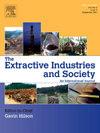Mineral resource exploitation and landownership rights: Understanding the ‘doctrine of custodianship’ in minerals and mining legislation in South Africa
IF 3.6
2区 社会学
Q2 ENVIRONMENTAL STUDIES
Extractive Industries and Society-An International Journal
Pub Date : 2025-01-12
DOI:10.1016/j.exis.2025.101611
引用次数: 0
Abstract
Legislation and policy frameworks on mineral resource exploitation and landownership rights in South Africa were heavily influenced by the Roman-Dutch law. These legal frameworks changed from 1795 with the annexation of the Cape by the British, and the discoveries of Gold and diamonds in the 19th century in South Africa. Expectedly, scholars have documented the evolution and development of mineral resources and landownership rights in South Africa. However, while there is interesting scholarship on mineral resource exploitation and landownership rights in South Africa, this scholarship fail to see mineral legislation from the perspective of eminent domain. Thus, this paper contextualized the doctrine of ‘custodianship’ as embedded in the Mineral and Petroleum Development Act of 2004 (MPRDA) within the conceptual framework of eminent domain. The paper uses discourse analysis to analyze historical and legal documents and academic literature. The analysis revealed that the doctrine of ‘custodianship’ as used in MPRDA connotes eminent domain. This is because the doctrine implies that nation's mineral resources are res publicae (belong to all South Africans, and the state is the custodian thereof). Looking at the notion of ‘custodianship’ in this way would open a new discussion on mineral resource discourse in post-apartheid South Africa.
矿产资源开采和土地所有权:了解南非矿产和采矿立法中的“监护原则”
南非关于矿产资源开采和土地所有权的立法和政策框架深受罗马-荷兰法的影响。这些法律框架从1795年起随着英国吞并好望角和19世纪在南非发现黄金和钻石而改变。不出所料,学者们已经记录了南非矿产资源和土地所有权的演变和发展。然而,尽管在南非的矿产资源开采和土地所有权方面有一些有趣的研究,但这些研究没有从土地征用权的角度来看待矿产立法。因此,本文将《2004年矿产和石油开发法案》(MPRDA)中嵌入的“监护”原则置于土地征用权的概念框架中。本文运用话语分析法对历史法律文献和学术文献进行分析。分析表明,MPRDA中使用的“监护”原则意味着征用权。这是因为该学说暗示国家的矿产资源是公共资源(属于所有南非人,国家是其保管人)。以这种方式看待“监护”的概念将开启关于种族隔离后南非矿产资源话语的新讨论。
本文章由计算机程序翻译,如有差异,请以英文原文为准。
求助全文
约1分钟内获得全文
求助全文
来源期刊

Extractive Industries and Society-An International Journal
ENVIRONMENTAL STUDIES-
CiteScore
6.60
自引率
19.40%
发文量
135
 求助内容:
求助内容: 应助结果提醒方式:
应助结果提醒方式:


